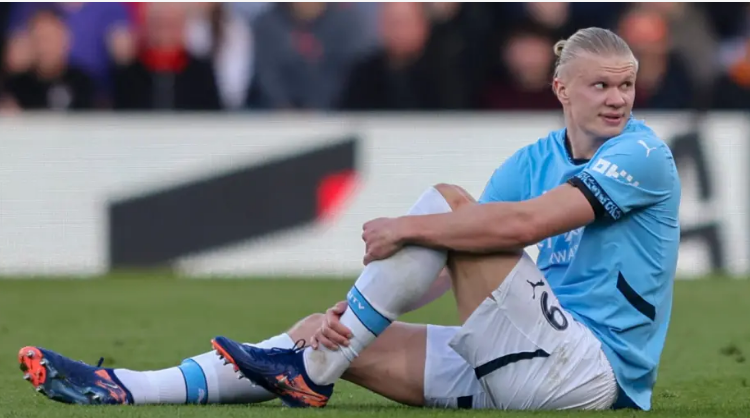Understanding Erling Haaland’s Injury
Erling Haaland, the prolific striker for Manchester City, has recently been sidelined due to an ankle injury that has raised concerns among fans and analysts alike. The injury reportedly occurred during a match in the FA Cup, where he made a quick turn in an attempt to evade a defender, leading to an unnoticed twist that could have significant implications for his playing capability.
Medical evaluations have indicated that Haaland has sustained damage to the ligaments in his ankle. This type of injury is not uncommon in football, particularly for players who rely heavily on agility and speed. Symptoms observed include swelling, discomfort, and a reduced range of motion in the affected joint. Initially, Haaland has been advised to rest and undergo physiotherapy as part of his treatment plan; however, the severity of the injury may require a more specialized approach.
The specialist overseeing his case has emphasized the need for a comprehensive recovery strategy to ensure that Haaland regains his full range of motion and strength. Given his pivotal role in the Manchester City squad, the medical team is keen to take all necessary precautions. Instructor-led rehabilitation sessions are expected to be an integral part of his recovery process, offering tailored exercises aimed at restoring his ankle’s function while preventing further injury.
Furthermore, the potential timeline for his return has not been definitively established, as the extent of the ligament damage will directly influence how quickly he can return to match fitness. As such, Manchester City fans remain hopeful that the club’s medical staff will facilitate a successful recovery, allowing Haaland to return to the pitch and continue his noteworthy contributions to the team.
Potential Implications for Manchester City
The recent ankle injury sustained by Erling Haaland raises significant concerns regarding his role within Manchester City for the remainder of the season. Haaland has established himself as a pivotal figure in the team, consistently contributing through goals and assists, which underscores his integral role within the tactical framework set forth by the coaching staff. His ability to find the net in crucial moments makes his absence particularly alarming, especially given Manchester City’s ambitious targets in both the Premier League and FA Cup.
From a strategic standpoint, Haaland’s presence on the pitch has a substantial impact on opposing defenses. His remarkable pace and finishing ability often stretch defenses, creating space for teammates to exploit. Without him, Manchester City may find it challenging to maintain the same attacking fluidity they have demonstrated throughout the season. This could lead to a shift in tactics, requiring other forwards or midfielders to adapt to a potentially more static role in the absence of such a dynamic player. Coaches and analysts may need to reassess tactical approaches to ensure that the team’s offensive output is not adversely affected.
Moreover, Haaland’s injury could also influence team morale. The squad’s collective confidence may waver without their star striker, as players might feel the pressure to elevate their performances to compensate for his absence. Upcoming fixtures, particularly in high-stakes matches like the FA Cup, will test the depth and resilience of the squad. Wingers, midfielders, and other forwards will need to share the burden that Haaland would typically carry. The coaching staff will likely explore alternative formations or player combinations to mitigate the impact of his injury. Consequently, while the team grapples with the situation, it will be crucial for Manchester City to display adaptability as they navigate the challenges posed by Haaland’s ankle injury.
Haaland’s Career: A Timeline of Injuries and Recovery
Erling Haaland’s career has been marked by exceptional talent and, unfortunately, a series of injuries that have tested his resilience. Since his early days, injuries have played a pivotal role in shaping his trajectory as a professional footballer. Notably, his time at Borussia Dortmund included a substantial ankle injury that sidelined him for several weeks. This setback occurred during the 2020-2021 season, impacting his participation in crucial matches, including the UEFA Champions League fixtures. However, his ability to recover swiftly from this injury demonstrated his commitment to maintaining peak physical condition.
Transitioning to Manchester City in 2022, Haaland quickly became a pivotal player. Nevertheless, concerns over his fitness resurfaced when he sustained another ankle injury during the FA Cup campaign. This incident brought renewed fears to both fans and the club, as his consistent scoring had made him an integral part of City’s success. The injury forced him into a rehabilitation period under the watchful eye of specialists, where recovery protocols tailored for elite athletes were employed. Following this phase of inactivity, he returned to the pitch, showcasing not only his skill but also his capacity to bounce back from adversity.
The situation reflects a broader narrative familiar to many top athletes who contend with the physical toll of high-level competition. Comparisons can be drawn with peers, such as Virgil van Dijk and his lengthy recovery from injury, illustrating the universal challenges faced in professional sports. While Erling Haaland’s ankle injuries have presented hurdles, they have also catalyzed his development as a more mentally resilient player, ready to face the demanding challenges ahead in the world of football. This journey underscores the importance of dedication, perseverance, and the invaluable support of medical professionals in managing sports-related injuries.
What Fans Can Expect Going Forward
Erling Haaland’s ankle injury has raised significant concerns regarding his future performance with Manchester City. As one of the standout players in the Premier League, his absence could impact both personal statistics and the team’s objectives for the FA Cup and the ongoing league campaign. Once he receives a full evaluation from a specialist, a clearer picture of his recovery timeline will emerge. Typically, similar ankle injuries can lead to recovery periods ranging from a few weeks to several months, depending on the severity. This uncertainty leaves fans and analysts speculating on the duration of his sidelining.
As for what fans can expect during Haaland’s recovery, it is essential to note that Manchester City has a strong support system for athletes. The club emphasizes physical therapy and rehabilitation, ensuring players, including Haaland, have access to necessary resources. During this time, team dynamics will inevitably shift as the coaching staff explores different tactical options to compensate for his absence. The performance of alternative strikers will be closely scrutinized, and the results may influence how fans perceive Haaland’s role within the squad upon his return.
While supporters may feel anxious about the potential ramifications of this injury, they can also anticipate the athlete’s resilience. Historically, athletes such as Haaland have demonstrated remarkable recovery capabilities, often returning to the pitch stronger than before. Fans can also expect regular updates from the club regarding his recovery process, which can help alleviate concerns. Thus, while the immediate future presents challenges, Haaland’s eventual return is a source of optimism for Manchester City and its dedicated fanbase. In conclusion, while uncertainties remain, fans are encouraged to remain supportive during this recovery phase as the team navigates the season ahead without him.

